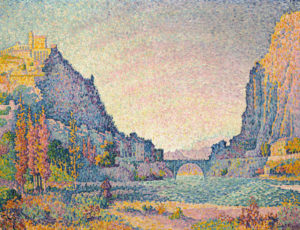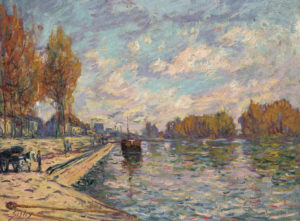Alan Hartman owned Hartman Rare Art on New York’s Madison Avenue for decades until his passing earlier this year. He was considered an expert in Chinese jade carvings, East Asian antiquities, and English silver. When his widow Simone consigned their collection to Bonhams, many expected such work to feature heavily in the sale. In some ways, they were right, but in other ways, the couple's modern and impressionist paintings dominated the December 14th evening sale. Of the one hundred eleven available lots, only twenty-two were paintings, or about 20% of the collection. There were also three sculptures; the remaining eighty-six were decorative pieces, porcelain, jade carvings, and antiquities. However, despite constituting only a small portion of the collection, the paintings comprised the vast majority of the money from the sale.
The top three lots were all late nineteenth- and early twentieth-century French impressionist paintings, which came across the block within the first twenty lots. The expected first-place lot was Paul Signac’s Sisteron, showing the small town of the same name in southeastern France. The town straddles the Durance River, with two steep rocky hills rising above. The town is often called the Gateway to Provence because of this feature. The painting last sold at auction when Hartman purchased it at Sotheby’s New York in 1981 for $310K hammer. The Signac exceeded Bonhams’ $6 million maximum prediction, achieving $7.1 million (or $8.58 million w/p). Seven lots later, there was a bright and colorful Monet, La Seine près de Giverny. Executed in 1888, Monet had only been living in Giverny, a small town outside of Paris, for five years when he created this placid, pink and green view of the River Seine. This painting is known as a creative breakthrough for the artist, resulting from months of artistic struggle following a trip to the French Riviera and disagreements with his dealers in Paris. Hartman bought this painting in 1978, again at Sotheby’s New York, for the bargain price of $290K hammer. Bonhams gave it the same estimate as the Signac, but it did not exceed this prediction. It fell nicely in the middle, with the hammer coming down at $5.2 million (or $6.35 million w/p). The third-place lot was also a painting of the Seine, this time done by Alfred Sisley in 1879. While the Monet focuses entirely on the beauty of nature, the Sisley shows the river with a human presence. Sisley gives us the Seine at Suresnes, a small town on the immediate outskirts of the west of Paris; we see a riverboat chugging along while people and horse-drawn carts occupy the space between the riverbank and the town’s buildings. In 1879, Sisley had been living in a Parisian suburb similar to Suresnes for several years, and he would soon move away to a small village to the southwest. Bonhams gave La Seine à Suresnes a slightly more modest estimate range than the Monet and the Signac, predicting it would sell for between $1 million and $1.5 million. Sisley’s suburban scene hit the low estimate exactly ($1.27 million w/p).
By the time the Sisley sold, the Hartman Collection had already met its $15 million total minimum estimate. Of the one hundred eleven available lots, only twenty-two were paintings, making up about 20% of the sale. However, these paintings constituted 87.5% of the collection's total dollar amount. The top three lots alone brought in 73.8% of the sale’s total. The rest of the sale included sculptures, decorative art, and antiquities. However, that doesn’t mean that these pieces were not noteworthy. Many of them sold far beyond their initial estimates. Twenty lots made more than double their high estimate, or about 18% of the sale — a small handful even made over eight times their estimates. Lot 61 was a candle holder dating to the Tang dynasty, between the seventh and tenth centuries. It incorporates elements of a lotus flower held up by a dragon coiled below. Estimated to sell for no more than $5K, the antique Chinese candle holder eventually sold for $48K (or $61.4K w/p), over nine-and-a-half times the initial estimate. Earlier in the sale, however, was a large, glazed earthenware statue, measuring slightly over 32 inches tall, showing a Ming dynasty official in vibrant yellow and green robes. It sold for $130K (or $165.6K w/p) against an initial high estimate of $12K. And finally, the biggest surprise of the sale, or any sale in the past few months, came in the form of a small ancient sculpture in the shape of a tiger. Made from bronze and measuring just under 7 inches long, this crouching tiger was likely made between the fifth and third centuries BCE, during the Eastern Zhou dynasty. Regardless of whether it was its age or its subject that drew people to it, several bidders just wouldn’t let it go. Expected to sell for between $10K and $15K, the small bronze tiger eventually sold for an astounding $340K (or $432.3K w/p), more than twenty-two times the estimate.
By the end, thirty-eight of the one hundred eleven lots sold within their estimates, giving Bonhams’ specialists a 34% accuracy rate. That number is impressive by itself, even more so when accompanied by an additional forty-eight lots (43%) sold above estimate. Only fifteen lots (14%) sold below, while ten lots (9%) were bought-in. The entire sale made $18 million against a total presale estimate range of $15.2 million and $22.47 million.



